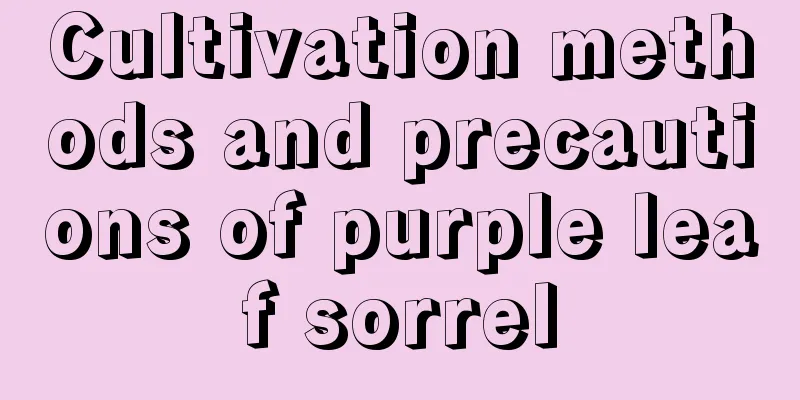Cultivation methods and precautions of purple leaf sorrel

1. Maintenance methods1. Temperature: The normal growth temperature is between 16 and 22 degrees. The resistance to cold and high temperatures is not high. The temperature in winter needs to be kept above 5 degrees, and the temperature in summer cannot exceed 35 degrees, otherwise the growth will stop and the plant will become dehydrated. 2. Watering: You need to adhere to the principle of not watering unless the soil is dry, and watering thoroughly when the soil is dry. During the spring growth period, you can increase the amount of watering to ensure that the soil has moisture. However, you don’t need to water too much in the summer because the plants begin to hibernate at this time. You only need to spray a little water around them to achieve the effect of replenishing water. 3. Light: It needs to receive sufficient warm sunlight. Except for summer, it can directly receive full sunlight in other seasons. At the same time, if the light is not sufficient, the color of the plant will become dark and the appearance will be seriously affected. 4. Fertilization: It is necessary to supplement the nutrients lacking in the soil. Do not apply too much during the growth period, otherwise it will burn the roots of the plants. Apply fertilizer almost every few months, mainly with compound fertilizers. Do not apply only one type. Excessive single fertilizer will cause the color of the plants to change. 2. Breeding techniques1. Reproduction: Division is the main method of reproduction. Division is crucial for it. The survival rate of this method is relatively high. After division, you can directly plant it in other pots. 2. Pruning: It is easy for the pot to fill up, thus affecting the overall ventilation and light transmission, so some short branches and leaves need to be pruned. 3. Problem diagnosis and treatment1. Disease: Leaf spot is the main disease, which will seriously affect its ornamental value, so wettable powder can be used to control it. 2. Pests: Red spider mites will appear more frequently, and they can generally be completely eliminated using pesticides. They can also be removed manually during the larval stage. IV. Other issues1. Toxicity: It is non-toxic, its color is very bright, and it is very commonly cultivated. 2. Can it be raised at home? Yes, its ornamental value is relatively high. When raising it at home, you need to pay attention to ventilation and light. You can directly open the window if possible. |
<<: Cultivation methods and precautions of branched apricot
Recommend
How to raise the Eight Desolate Palace
1. Breeding environment 1. Soil: The cultivation ...
Maintenance methods of Jade Plant
The Jade Plant, with its delicate and small leave...
Can forget-me-nots be planted in spring?
1. Can it be planted in spring? It is possible, b...
How to keep roses in pots during the winter (how to keep them safe during the winter)
Roses are cold-resistant plants that can withstan...
How to plant and care for aloe vera?
Aloe vera has thick green leaves that are lush an...
Should I use a large or small pot for Jade Dew?
Should I use a large or small pot for Jade Dew? J...
How to plant peony flowers? Planting time and method
Peony planting time Peonies are generally best pl...
When is the best time to plant lilies?
Lily , also known as rhododendron, is a perennial...
Classification of common osmanthus varieties
1. Osmanthus fragrans variety group It grows in a...
The reason why the roots of hydroponic daffodils rot and how to deal with it
1. Causes of root rot 1. Not changing the water f...
Why can't you grow white orchids at home?
1. Reasons why you can’t grow white orchids at ho...
How to grow orchids indoors in summer
1. Water Water evaporates quickly in summer, so i...
What flowers bloom in winter
1. Wintersweet The wintersweet flower blooms from...
Does the succulent money tree bloom?
1. Whether it blooms The succulent money tree wil...
How to grow newly bought cyclamen and how to water them in winter
1. Newly purchased maintenance method 1. Water: F...









